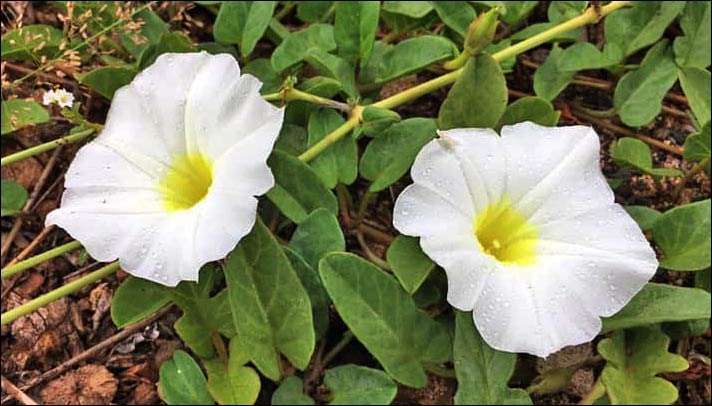Vulnerability of Coastal Dune Plants to Sea Level Rise
by Dr. Kasey Barton,
School of Life Sciences, UH-Mānoa

from the Coastal Dune’s of Maui
Beaches are an integral part of life in Hawai‘i. Providing recreation, tranquility, a site for celebration and mourning, and even sustenance, coastal areas are critical for our well-being. Coastal areas such as sandy dunes also provide critical habitat for coastal animals such as nesting seabirds and yellow-faced bees (Hylaeus genus). Coastal dunes have some of the most diverse native plant communities in Hawai‘i, and dune plants stabilize beaches, reducing erosion and providing resistance during big storm and wave events.
Some coastal dune plants like naupaka (Scaevola taccada) are probably recognizable to many as they are commonly used for landscaping in urban and suburban areas. Other common dune plants include pōhuehue, an indigenous morning glory (Ipomoea pes-caprae), pā‘ūohi‘iaka (Jacquemontia sandwicensis), and ‘aki‘aki grass (Sporobolus virginicus). Some coastal dunes in Hawai’i are also increasingly invaded by noxious species such as the thorned kiawe (Prosopis pallida) and the allelopathic ironwood (Casuarina equisetifolia).
Conserving native coastal dune plants is a conservation priority, which depends on understanding the ecology of dune species. Coastal environments are inherently stressful for plants. High solar radiation, intense winds, and trampling from human activities pose persistent challenges to plant survival and growth. In addition, periodic and unpredictable events such as big storms and king tides can devastate dune habitats. These are routine stressors that coastal dune plants face and, as a consequence, they have evolved traits and growth strategies to maximize stress tolerance. However, coastal environments are changing, and dune plants are increasingly threatened by climate change and habitat loss due to coastal erosion. For low-lying coastal zones, sea level rise poses a serious threat, leading to increasing salt water intrusion below the sand where roots access freshwater lenses.
A crucial question is whether coastal dune plants can tolerate increasing salinity, at least well enough to migrate inland as the sandy beaches erode due to sea level rise.
It seems likely that coastal dune plants can tolerate exposure to high salinity. Afterall, they routinely experience high tides and salt spray. However, most coastal dune plants depend on desalinization from rain, and roots access fresh water deep in the sand. Because climate change is leading to sea level rise as well as reduced rainfall across the Hawaiian Islands, it remains unclear whether native dune plants can tolerate the simultaneous stress of more salinity and less rainfall.
Since 2016, my lab at the School of Life Sciences at the University of Hawai’i at Mānoa has been investigating salinity tolerance in native coastal dune plants with the goal of characterizing general patterns across species. Together with Tamara Sherrill at Maui Nui Botanical Gardens, and Dustin Wolkis and Seana Walsh at the National Tropical Botanical Garden, we have received a SeaGrant award to further investigate salinity tolerance of coastal dune plants, with particular focus on young plant stages (seeds and seedlings), which tend to be the most sensitive to salt stress.
Using an experimental approach that simulates increased salinity by watering plants with ocean water, and observing responses in growth and survival, we aim to identify species that are very tolerant, providing robust species for restoration efforts, as well as to identify vulnerable species that will need to be prioritized for intensive management to conserve.
Among the twelve species tested to date, we are observing considerable variation in salinity tolerance, and the most tolerant native species is alaweo (Chenopodium oahuense), while the most sensitive species is lemuomakili (Vigna marina). Our future efforts will continue to expand the species tested for a more comprehensive understanding of coastal dune vulnerability to sea level rise. Considering the evidence to date that many dune plants are sensitive to salinity, we are developing seed bank collections of native dune species at MNBG and NTBG to provide the propagules for future restoration and possible assisted migration inland where coastal erosion and increased salinity won’t threaten the persistence of these native species.
Banking seeds now while dune communities are still diverse offers a promising approach to ensure conservation of these critical Hawaiian ecosystems in the future.

